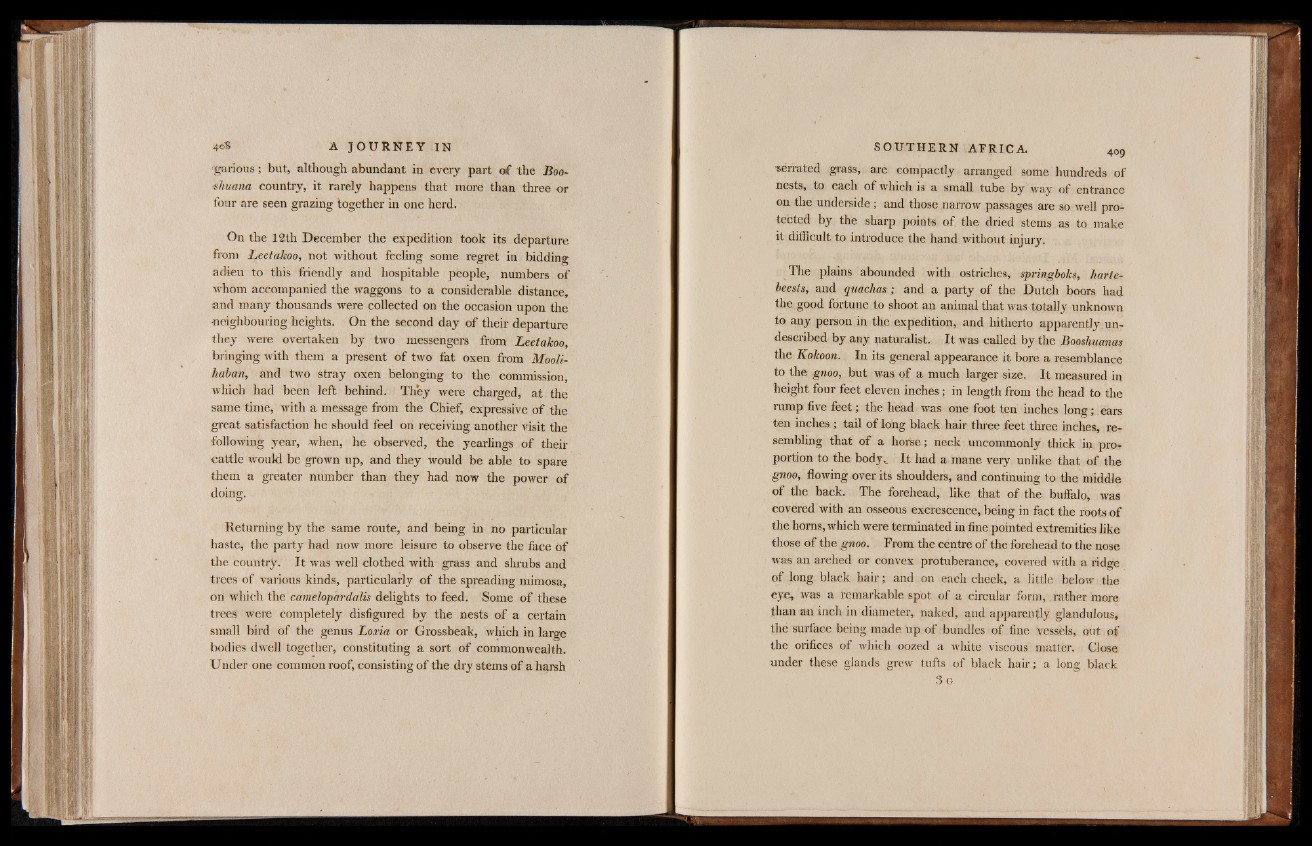
garious; but, although abundant in every part of the Boo-
■shuana country, it rarely happens that more than three -or
four are seen grazing together in one herd.
On the 12th December the expedition took its departure
from Leetakoo, not without feeling some regret in bidding
adieu to this friendly and hospitable people, numbers of
whom accompanied the waggons to a considerable distance,
and many thousands were collected on the occasion upon the
■neighbouring heights. On the second day of their departure
they were overtaken by two messengers from Leetakoo,
bringing with them a present of two fat oxen from Mooli-
liaban, and two stray oxen belonging to the commission,
which had been left behind. They were charged, at the
same time, with a message from the Chief, expressive of the
great satisfaction he should feel on receiving another visit the
following year, when, he observed, the yearlings of their
cattle would be grown up, and they would be able to spare
them a greater number than they had now the power of
doing.
Returning by the same route, and being in no particular
haste, the party had now more leisure to observe the face of
the country. I t was well clothed with grass and shrubs and
trees of various kinds, particularly of the spreading mimosa,
on which the Camelopardalis delights to feed. Some of these
trees were completely disfigured by the nests of a certain
small bird of the genus Loxia or Grossbeak, which in large
bodies dwell together, constituting a sort of commonwealth.
Under one common roof, consisting of the dry stems of a harsh
■seriated grass, are compactly arranged some hundreds of
nests, to each of which is a small tube by way of entrance
on the underside; and those narrow passages are so well protected
by the sharp points of the dried stems as to make
it difficult to introduce the hand without injury.
The plains abounded with ostriches, springboks, harte-
beests, and quachas; and a party of the Dutch boors had
the good fortune to shoot an animal that was totally unknown
to any person in the expedition, and hitherto apparently undescribed
by any naturalist. It was called by the Booshuanas
the Kolcoon. In its general appearance it bore a resemblance
to the gnoo, but was of a much larger size. It measured in
height four feet eleven inches; in length from the head to the
rump five feet ; the head was one foot ten inches long; ears
ten inches; tail of long black hair three feet three inches, resembling
that of a horse; neck uncommonly thick in proportion
to the body.. I t had a mane very unlike that of the
gnoo, flowing over its shoulders, and continuing to the middle
of the back. The forehead, like that of the buffalo, was
covered with an osseous excrescence, being in fact the roots of
the horns, which were terminated in fine pointed extremities like
those of the gnoo. From the centre of the forehead to the nose
was an arched or convex protuberance, covered with a ridge
of long black h a ir; and on each cheek, a little below the
eye, was a remarkable spot of a circular form,. rather more
than an inch in diameter, naked, and apparently glandulous,
the surface being made up of bundles of fine vessels, out of
the orifices of which oozed a white viscous matter. Close
under these glands grew tufts of black hair; a long black
3 <!